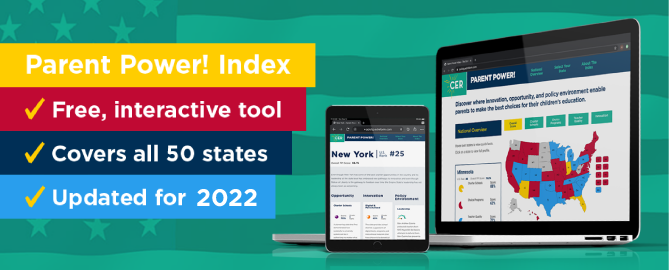Breakthrough in School Choice (Adam Schaeffer)
Utah has just approved the nation’s first universal school choice program, and in New York, Eliot Spitzer has become the first Democratic governor to propose a private school choice program in his state budget. These two firsts are a major shot in the arm for education reform, and they offer a glimpse of the possibilities to come.
With the Utah House voting 38-37 and the Utah Senate voting 19-10, the Republican-dominated Legislature passed the nation’s first general — rather than targeted — school choice program, and Governor Huntsman, a Republican, signed it into law. There’s still a long way to go until this program has a chance to mature into something that will revolutionize education. Private schools will be concerned that the political tides might turn against the program, and even with certainty that the program will stay, it will take time for them to respond to families’ demands.
Caveats aside, Utah has breached a major barrier to real education reform. Past programs, like those in Wisconsin and Ohio, have targeted small, special populations such as children with disabilities or low-income children. Utah’s is the first program to treat school choice as a general education reform that can and should help all citizens. Every family deserves a real choice of schools, all children deserve an education that works for them, and all taxpayers deserve control over how their education dollars are spent.
Unfortunately, the Utah victory shows that Democrats are still strongly opposed to vouchers, and Republicans remain ambivalent. Not one Democratic legislator voted for the voucher bill, and only an overwhelming Republican majority allowed it to pass. But a hefty 31% of Republican representatives voted "nay" with the Democrats.
Fortunately, another recent turning point provides hope that the political problems of school choice can be substantially mitigated. Governor Spitzer proposed a tax deduction for private school tuition in his 2008 budget. At $1,000, the deduction is very small, but it’s a huge political break-through.
Mr. Spitzer is a savvy and popular Democratic politician, and some see him as a future presidential contender. Last year, he expressed his opposition to school vouchers but said, "I support the idea of education tax credits."
And Mr. Spitzer now supports tax deductions in fact. From a major Democratic politician with national ambitions, this is real movement.
Mr. Spitzer’s support provides evidence — the Democratic state of Rhode Island passed a school tax-credit bill last year — that education tax credits can lower the admittedly massive political barriers to full school choice. States without Republican supermajorities need to pursue school choice policy with the broadest support and best chance in court, especially if they hope to pass school choice legislation with broad coverage and real benefits for all citizens. In most states, that means education tax credits, which more moderate Republicans and Democrats support and state courts have upheld.
If Mr. Spitzer’s modest tax deduction passes, it will show that the school choice issue is politically viable in New York and establish a new negotiating base for the growing movement for educational freedom. It will encourage grassroots supporters and provide leverage for their representatives, who will be able to adapt and expand the law in years to come.
The barriers to school choice remain high, but the routes around and through them are increasingly clear. Now that the seal has been broken, supporters should push for programs that allow all families to choose where their children are educated. It’s only natural, and as Utah and New York have shown, it’s time.
Mr. Schaeffer is a policy analyst for the Center for Educational Freedom at the Cato Institute. This column previously appeared in the New York Sun.













Like stones cast into the public education waters, charter schools create ripples that can affect conventional public schools nearby. Find out more. See Charter Schools Today: Stories of Inspiration, Struggle & Success, by award-winning journalist Joe Williams and published by The Center for Education Reform. https://2024.edreform.com/index.cfm?fuseAction=document&documentID=2588§ionID=55
With respect to state prohibitions on choice: I don’t disagree that state constitutions supersede the U.S. Constitution where state eduspending is concerned. But those state prohibitions, generally in the form of Blaine amendments, have a rather troubled history:
Which leads to another point regarding parents’ choice of schools. It’s entirely possible you will make a parental choice with which I disagree. So what? They’re your kids, not mine. I trust you to make that determination. Personally, I wouldn’t send my kid to a Catholic school, but that doesn’t mean you shouldn’t have that opportunity. I’m less concerned about where learning takes place and more concerned about whether it takes place.
Understand, I’m hardly badmouthing tax credits; after all, the Alliance has done a lot to promote tax credit programs in a number of states (most recently passing some innovative programs here in Arizona). And for good reason: they’re instrumental in providing opportunities to disadvantaged children. But we need more.
Ryan, here are my responses to your responses.
1) As to which private schools receive tax dollars: the concept behind school choice is the child benefit principle. In other words, the voucher is given to the student, not the school he or she attends.
-With vouchers the funding is attached to the student, but that student may choose to go to a private school that you may not like.-
2) As to control over where the money is spent, it depends on the program’s design. In many cases, tax credit donations are directed to scholarship granting organizations, which then award scholarships to students attending a wide array of schools. In that respect, then, the difference between vouchers and tax credits is negligible.
-With education tax credits you can choose a scholarship granting organization that gives scholarships to certain groups of students or to particular private schools. You could choose a scholarship granting organization, for example, that donates only to catholic schools or only to students living in a certain city. With vouchers, your tax dollars could be spent at non-catholic schools or students living in any city in the state. Education tax credits allow you to more precisely control where money is spent than vouchers do.-
3) Some state constitutions are more favorable to school choice than others, but the constitutionality of school choice was resolved by the Zelman decision, which in 2002 removed any obstacles to school choice on the federal level.
-Since it is at the state level where most education spending occurs, the state constitutional prohibitions on school vouchers supersede the constitutionality of school vouchers at the federal level.-
Three responses:
1) As to which private schools receive tax dollars: the concept behind school choice is the child benefit principle. In other words, the voucher is given to the student, not the school he or she attends.
2) As to control over where the money is spent, it depends on the program’s design. In many cases, tax credit donations are directed to scholarship granting organizations, which then award scholarships to students attending a wide array of schools. In that respect, then, the difference between vouchers and tax credits is negligible.
3) Some state constitutions are more favorable to school choice than others, but the constitutionality of school choice was resolved by the Zelman decision, which in 2002 removed any obstacles to school choice on the federal level.
Education tax credits are more legally defensible than vouchers because they do not use public funds and are more politically defensible because the user of the education tax credit has control over where there money is spent, in contrast to vouchers where there is no control over which private schools receive your tax dollars.